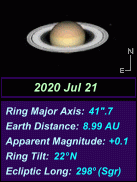Saturn's Orbit and the
Changing Aspect of the Rings
by Martin J. Powell
The orbit of Saturn shown at two/three year intervals between the years 1993 and 2020 AD (click for full-size image, 97 KB). The orbit of the Earth is seen close to the centre, marked at various dates by a blue-green globe (the orbits are not shown to scale). The dates in blue are the dates of Saturn's opposition to the Sun, i.e. when the planet is closest to the Earth and appears at its brightest for the year. The images in the grey circles show how the planet appears from the Earth (orientated with Celestial North at the top). The points of Saturn's perihelion (i.e. its closest point to the Sun) and aphelion (its most distant point from the Sun) are also marked. The constellation in which Saturn appears, as seen from the Earth, is shown in green. The First Point of Aries is the 'zero point' from which the longitudes of the planets are measured (diagram based on a graphic by space artist David A Hardy).
Saturn's rings contribute a great deal to its brightness, and in fact, from the vantage point of the Earth, they are not always fully on view. About every 13 to 16 years, the rings are edgewise-on to the Earth's line-of-sight, when they are only seen as a thin line in telescopes - or sometimes not at all - and the planet appears much dimmer in the sky.
Saturn takes a little under 29½ years to orbit the Sun and during this time we see the rings from different angles. In mid-2003 Saturn's Southern hemisphere was tipped in our direction and the rings were fully open to view, tilted at their maximum angle of 26°.9. The rings then began to close up, showing a narrower and narrower aspect, with Saturn becoming rather dimmer at each successive opposition. The rings appeared edge-on to the Earth in September 2009, when the Earth passed through the planet's ring plane (although at this particular time, Saturn appeared very close to the Sun when seen from the Earth). The Northern face of the ring came into view during the latter part of 2009, as they slowly began to open up once more. The ring system was last fully open to view in late 2017, when Saturn's Northern hemisphere was tipped in our direction. The rings will next be edge-on to the Earth in March 2025 and fully open in May 2032. Within any given apparition, the angle of Saturn's rings as seen from the Earth may vary by up to several degrees, depending upon the specific orbital geometry of the two planets.
 Animation
showing the changing aspect of
Saturn's
rings at various opposition dates from 1993 to 2020, with additional
orbital and observational details (click for full-size animation, 95 KB). The image is shown with Celestial
North up (note
that astronomical telescopes will normally show images inverted).
Saturn
images adapted from NASA JPL's Solar
System Simulator
('SPACE')
Animation
showing the changing aspect of
Saturn's
rings at various opposition dates from 1993 to 2020, with additional
orbital and observational details (click for full-size animation, 95 KB). The image is shown with Celestial
North up (note
that astronomical telescopes will normally show images inverted).
Saturn
images adapted from NASA JPL's Solar
System Simulator
('SPACE')
When the rings are wide open (i.e. when Saturn is brightest) the planet is seen in the constellations of Taurus or Gemini (when its Southern hemisphere is facing Earth) or in Scorpius, Ophiuchus or Sagittarius (when its Northern hemisphere faces Earth). Edge-on ring aspects occur when the planet is on the Aquarius/Pisces border (when oppositions take place around September) or in Leo (oppositions taking place around March).
Like the other Solar System planets, Saturn's orbit is somewhat elliptical, the result being that its distance from the Sun varies from year to year. When it is closest to the Sun (at perihelion), it lies some 9.03 Astronomical Units (AU) from the Sun; when it is furthest away (at aphelion) it is 10.06 AU from the Sun (where 1 AU = 149,597,870 km or 92,955,807 statute miles).
At perihelic oppositions, Saturn is about 743 million miles (1,197 million kms) from the Earth, whilst at aphelic oppositions it is some 1,027 million miles (1,654 million kms) from the Earth. Because of its varying distance from the Sun, Saturn's apparent size (its angular diameter when seen from the Earth) changes slightly from one opposition to the next.
Saturn reaches opposition to the Sun every 378 days, i.e. about 13 days later in each successive year. It moves relatively slowly through the zodiac, typically spending two or three years in each constellation before crossing into the next. For example, Saturn was positioned in the constellation of Virgo, the Virgin, from late 2009 through to late 2012.
To see a star chart showing Saturn's current position in the night sky, see the Saturn page.
Copyright Martin J Powell 2005-2019
Site hosted by TSOHost |